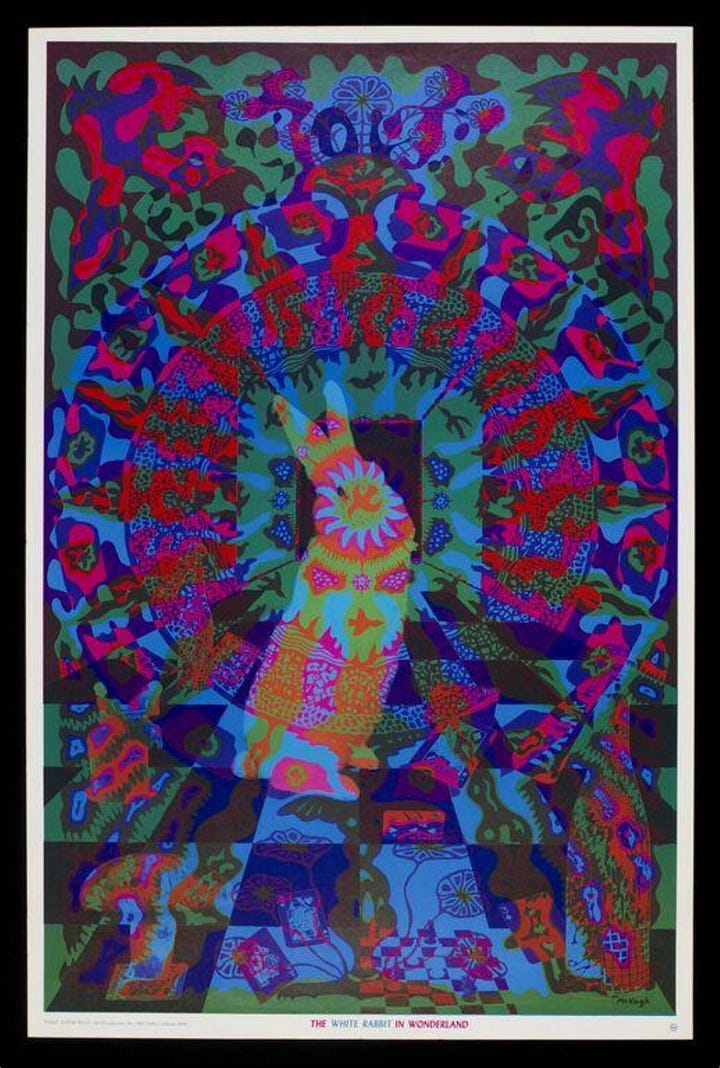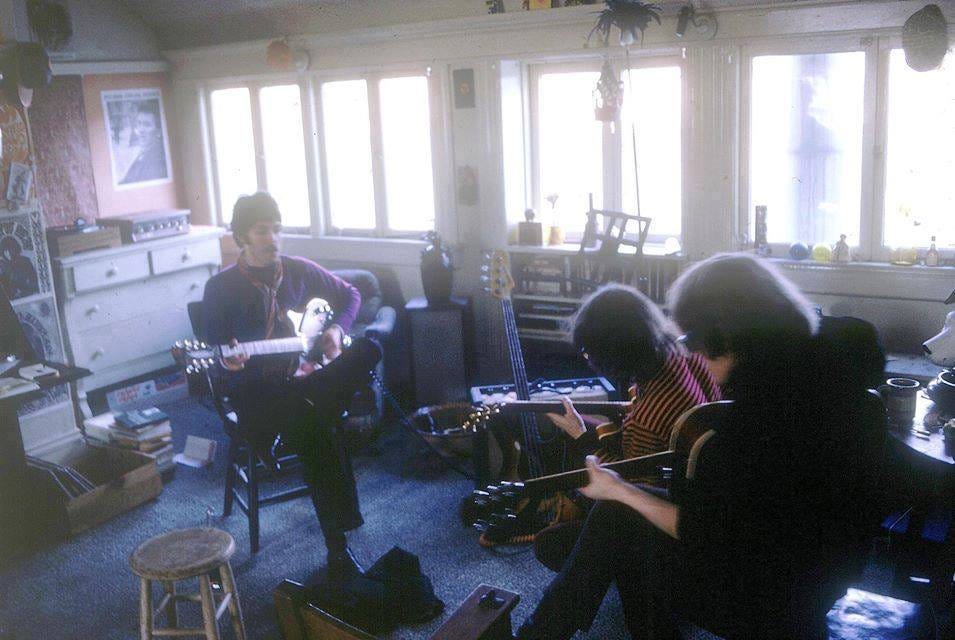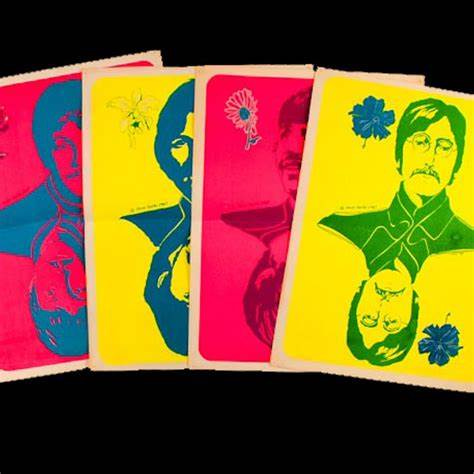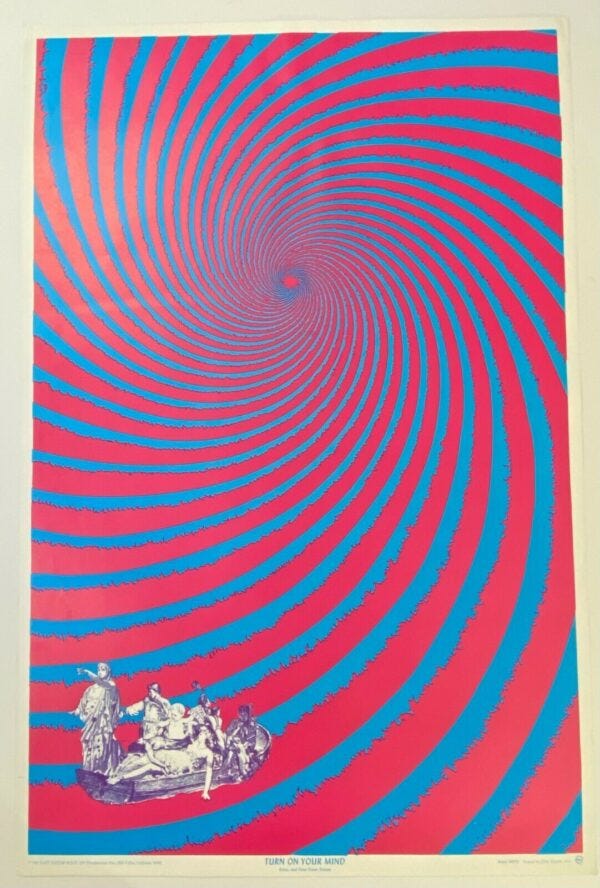Last night I rewatched The Matrix for the first time in a very long time. It was a lot of fun. But its reputation is down to its ideas, I think. I know people who happily quote the movie as though it were scripture. And it has the intoxicating perfume of late 20th Century pop philosophy.
But I’d maybe forgotten quite how much Alice is in there.
From the “follow the white rabbit….” text on the computer screen, to the white rabbit tattoo on the girl’s shoulder, to Morpheus asking Neo “I imagine right now, you feel a bit like Alice, tumbling down the rabbit hole?”. The allusions are anything but disguised!
And then there are the pills. One for hard, unflinching, reality, one for blissful ignorance. Make a choice. Red or blue.
This choice of pills is a bifurcating path. The narrative spark. Inevitably, it also recalls Alice. Eat Me! Drink Me! Do I follow the rabbit? Or stay put? And most of all, the Caterpillar’s mushroom, that Alice nibbles.
“In a minute or two the Caterpillar took the hookah out of its mouth and yawned once or twice, and shook itself. Then it got down off the mushroom, and crawled away in the grass, merely remarking as it went, 'One side will make you grow taller, and the other side will make you grow shorter.'"
-Lewis Carroll, Alice’s Adventures in Wonderland (1865)
But how do you go from mushrooms to pills (please, don’t snigger at the back…)?
The answer is Grace Slick, celebrated singer of Jefferson Airplane, and composer of a curious song, 1967’s White Rabbit, that’s part Lewis Carroll and part Miles Davis (Slick was listening to Sketches of Spain on acid).
It starts with a bassline, playing a bolero rhythm and moving a semi-tone up and then back down, before Slick enters:
One pill makes you larger
And one pill makes you small
And the ones that mother gives you
Don't do anything at all
Go ask Alice
When she's ten feet tall-Grace Slick, White Rabbit (1967)
I’ve only just realised this morning — trying to find direct links from ‘White Rabbit’ to The Matrix — that the trailer for sequel Matrix Resurrections is set to a familiar tune…
So there we have it.
Quick sidebar
…Or so I thought. Since I published this 3 hours ago, one of my subscribers has revealed the mystery of the colours… Carroll’s 1889 novel Sylvie & Bruno (a truly under-read tome). In vol 1. chapter 6, in Elfland Sylvie’s father offers her two lockets, one blue (‘all will love Sylvie’), one red (‘Sylvie will love all’). She chooses red.
Thanks Sean!!
Anyway back to White Rabbit and the 60s. The song is a cultural landmark — an anthem for the counterculture — that reinforces the status of Carroll as a kind of prophet of psychedelia, just as he’d become the herald of surrealism (perhaps no surprise either that the Jefferson Airplane album the song is on is called Surrealistic Pillow).
The final lines of the song - “Feed your he-aaaad, feed your he-aaad” act as a clarion call for an age of curiosity and expanded consciousness.
The 1960s resembled Wonderland for me. Like Alice, I met all kinds of strange characters, but I was comfortable with it […] Psychedelic drugs showed you that there are alternative realities. You open up to things that are unusual and different, and, in realising that there are alternative ways of looking at things, you become more accepting of things around you.
The line in the song “feed your head” is both about reading and psychedelics. I was talking about feeding your head by paying attention: read some books, pay attention.
-Grace Slick & Jack Casady, “How we made White Rabbit”, The Guardian.
Alice imagery can’t be pinned down to one source. Still less one song. She’s pretty omnipresent in 60s culture, and especially in countercultural contexts. I wish I could lay may hands on some of these for example:


Now psychedelia in the US and in the UK have similar, but subtly different flavours. Broadly, in the US it’s the continuation of the Beat generation (Kerouac, Burroughs…) and the 50s, and heavily entwined in political activism and the civil rights movement. In the merry old England, it’s more pastoral, more nostalgic. Victoriana is a major component (as we’ll see when we come to Sgt Pepper).
I’ve become quite fascinated by headshops — boutiques for drug paraphernalia and related culture (posters, magazines, incense etc) that started in California and soon spread around the world. Here’s the very first, in 1966, in San Francisco:
The thing I most love about these shops is the crazy brilliant posters they sold. And Alice is a deep, deep, well of inspiration for headshop poster imagery. Once you’ve seen Cheshire Cat it’s hard to forget; it’s certainly etched in my brain. And it’s not just the imagery, it’s the message — “we’re all mad” — that seems to capture the mood of the moment so brilliantly.
This poster is by Joseph McHugh, founder of East Totem West. Next week I have a treat for you, in the form of an original interview I did with Joe’s second wife, Jan. We talked about the most famous poster of all — here we go again — White Rabbit. It was an absolute sensation: “single footedly, this humble hare catapulted East Totem West into a full-fledged business within the space of a few weeks”.1
Instead of “feed your head” in Slick’s song, we see the words “keep your head”. Did McHugh copy Slick? Or was it coincidence. Alan Bisbort, chronicler of East Totem West, states clearly “the sketches […] were on the drawing board when the song ‘White Rabbit’ was released”. Perhaps in the “compressed and synchronistic days” of 1967 it was all just in the water somehow.
Here’s what Jan McHugh has to say.
“He may have been thinking about the Red Queen – “off with your head”… and also intrinsically the thing about LSD… in his opinion, you were keeping your head, it was more real than what you think of as reality. To him it was never really tripping, it was being. Our “real world” is what’s kind of tripping to him. He lived that idea right to the end.”
Jan McHugh, interview with the author, 2023.
We’re back to that idea that “nothing is real” and Strawberry Fields Forever. Dreaming with our head lying on a surrealistic pillow.
“Surrealism to me is reality. Psychedelic vision is reality to me and always was.”
-John Lennon
If Alice fuelled loads of counterculture imagery and philosophy — creating a portal between mid 1860s and 1960s — the Beatles were just as omnipresent, and headshop posters also riff on their images and words.
Steve Sachs, for example, made these beauties:
And Wilfried Sätty, the other main artist in the East Totem West stable, transformed the famous opening lines — via Timothy Leary and the Tibetan Book of the Dead — of ‘Tomorrow Never Knows’ into another iconic message. From Lennon’s “turn off your mind, relax and float downstream” to Sätty’s “Turn on your mind”:
Here’s a close-up for good measure:
Now one of the most curious features of the headshop posters was the psychedelic quality of the imagery when seen under ‘black light’ which creates a kind of 3D experience. East Totem West regularly added extra layers on top of existing ‘classics’, merging and blurring image worlds into a single work. They were often small runs, and it was really a totally experimental, hit-and-miss process.
I was pretty pleased to discover this “overprint” of Turn On Your Mind showing The Beatles in different poses. It’s quite meta(textual) when I think about it. A commentary on its own form. So beyond just a simple quotation from the song, the overprinting process echoes overdubbing, and many other features of the Beatles creative process. Specifically here, I think it’s echoing the use of tape loops on ‘Tomorrow Never Knows’. A really loopy visual for a loopy song.


And that’s about it for this week’s episode.
Except that the Beatles weren’t in California in spirit only. George ended up visiting Haigh Ashbury in ‘67 and was horrified at the mayhem and degradation (it’s often said that the real summer of love was a year earlier, in ‘66).
Paul also visited California around this time. In fact — a topic I’ll save for a later post — Ken Kesey’s ‘Merry Pranksters’, which he heard about in California, inspired Magical Mystery Tour. McCartney also ended up recording himself munching on celery for the Beach Boys track ‘Vega-Tables’.2
But there are also Jefferson Airplane connections too. And even this photo, showing Paul jamming with two of the band’s members.

You know that thought-experiment where people ask if you could go back to any point in history? It’s the kind of question that I find quite annoying, and yet, today I think I have an answer. I’ll let Marty Balin set the scene.
“We sat and started to talk.
I said, ‘So what’s up with the Beatles?’.
Paul casually pulled a cassette from his pocket and said, ‘I happen to have a track from the new album,’ […]
“I pulled out my cassette player and popped it in. Out came ‘A Day In The Life’”.
Alice. White Rabbit. Beatles. Blacklight. LSD pins. Blotters. Headshops. Feed your head. Keep your head. Mind off. Mind on. Taller small. One pill…
The counter-cultural stew was well stirred.
See you next week for the interview with Jan McHugh.
Oh, and Happy Unbirthday to me.
Alan Bisbort, The White Rabbit and Other Delights. East Totem West, a hippie company 1967-1969 (Pomegranate Artbooks, California, 1996).













there's a great episode in Andrew Hickey's History of Rock Music in 500 Songs on Tomorrow Never Knows - I thought I'd linked to it but can't see it now (it's there but not there) ... so here it is again (maybe) https://500songs.com/podcast/episode-145-tomorrow-never-knows-by-the-beatles/